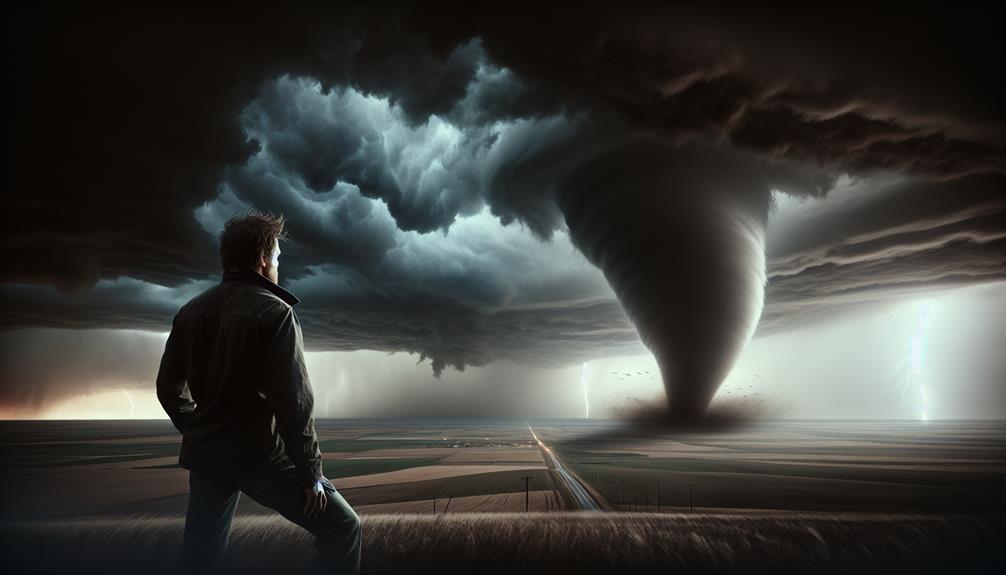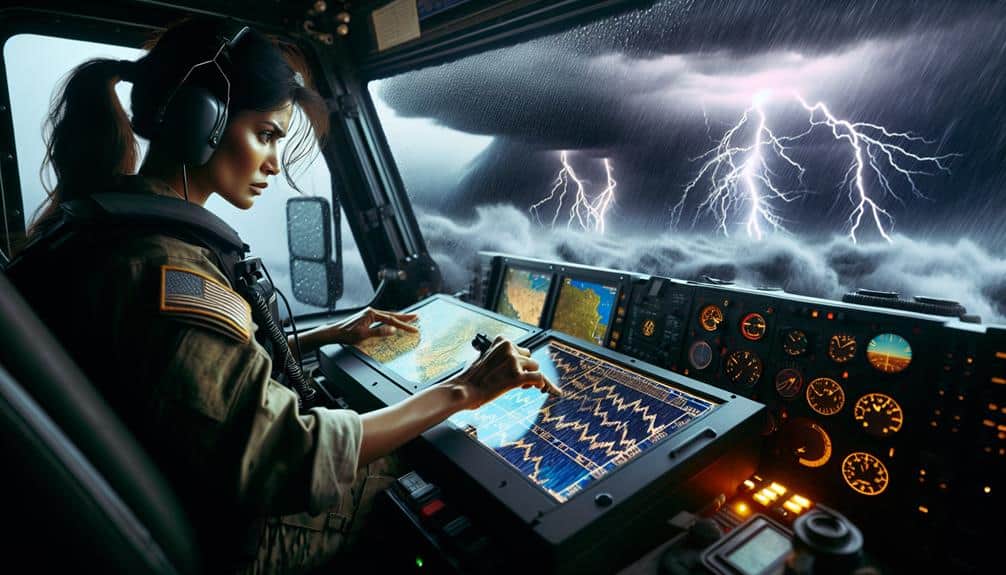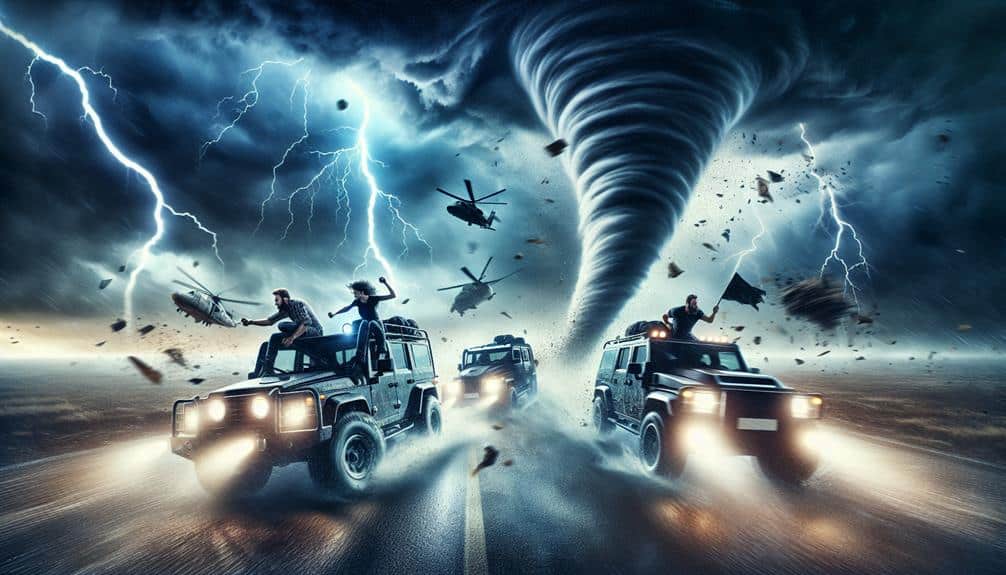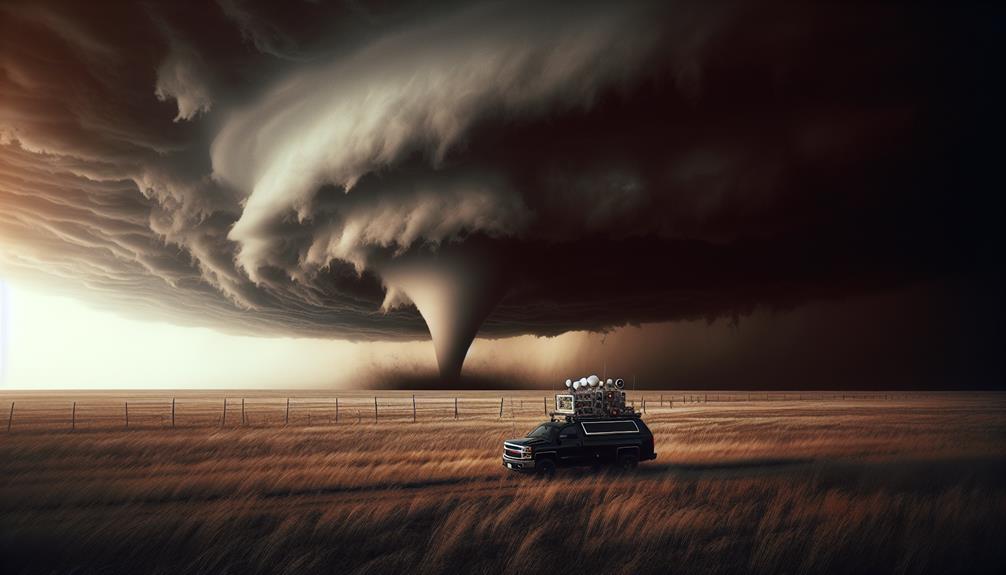Storm chasing teaches us invaluable lessons that extend beyond meteorology. By facing nature's ferocity head-on, we improve our risk assessment skills and survival instincts. Building unwavering team trust becomes imperative as we engage in high-stress situations, fostering resilience and adaptability. Embracing uncertainty sharpens our data analysis and communication strategies. Rigorous training hones our mental resilience, while curiosity drives us to unravel atmospheric complexities. We learn to value vulnerability and impermanence, leading to a profound appreciation for life's fleeting moments. Curious to understand how these intense experiences shape perspectives and fortitude?
Key Points
- Storm chasing fosters personal growth through facing natural forces and meticulous planning.
- Building unwavering team trust is critical for effective collaboration and decision-making in unpredictable environments.
- Embracing uncertainty helps cultivate resilience and a deeper appreciation for the power of nature.
- Developing mental and emotional fortitude is essential for navigating high-stress conditions and fostering resilience.
Facing Natural Forces
How do we prepare ourselves to confront the immense and unpredictable power of natural forces during a storm chase?
First, we recognize that personal growth is central to our journey. We arm ourselves with extensive knowledge of meteorological patterns, storm structures, and risk assessment. It's not just about understanding the science; it's about honing our survival instincts. Each decision we make in the field is a lesson in balancing courage with caution.
We meticulously plan our routes, ensuring we've multiple escape options in case the storm's path shifts. Our vehicles are equipped with essential survival gear, including first aid kits, water supplies, and communication devices. We practice driving in severe weather conditions, enhancing our ability to navigate treacherous roads and react quickly to sudden changes.
Our mental preparation is equally critical. We cultivate a mindset that embraces the unknown and remains calm under pressure. This mental fortitude is crucial for making swift, calculated decisions when confronted with nature's fury. Each storm chase is a test of our survival instincts, pushing us to adapt and grow.
Through this rigorous preparation, we gain not just technical skills but also a deeper understanding of ourselves and our place in the natural world.
Building Team Trust
As we prepare ourselves mentally and physically for the challenges of storm chasing, fostering unwavering trust within our team becomes essential to our collective success and safety. Trust isn't built overnight; it requires deliberate effort and structured processes. We engage in trust exercises designed to simulate high-pressure scenarios. These exercises range from communication drills to decision-making simulations, ensuring that every team member is proficient and reliable under stress.
Our leadership dynamics play a vital role in trust building. Effective leaders demonstrate transparency, distribute responsibilities evenly, and encourage open dialogue. By rotating leadership roles during preparatory phases, we guarantee that everyone understands the complexities and responsibilities of leading a storm chase. This inclusive approach not only enhances individual skills but also fortifies team cohesion.
Detailed team-building activities focus on developing mutual respect and understanding. We conduct post-exercise debriefings to discuss what worked well and where improvements are needed. These sessions are crucial for integrating lessons learned and reinforcing trust. Through consistent practice and reflection, we create a resilient, adaptable team capable of facing the unpredictable nature of storm chasing with confidence and unity.
This strong foundation of trust empowers us to navigate the inherent risks with greater freedom.
Embracing Uncertainty
As storm chasers, we thrive in unpredictability, constantly adapting to the volatile conditions that nature presents. Our resilience is tested and honed with each unexpected turn the weather takes, demanding quick, informed decisions.
Thriving in Unpredictability
Embracing the inherent unpredictability of storm chasing requires a mindset attuned to rapid adaptation and meticulous planning. We must develop improvisation techniques that allow us to make quick decisions based on real-time data, guaranteeing our actions are both calculated and flexible. This thriving mindset enables us to navigate the chaotic nature of storm systems with confidence and precision. It's not just about reacting to changes but anticipating them and positioning ourselves to leverage those shifts to our advantage.
To thrive in such an unpredictable environment, we focus on three critical areas:
- Data Analysis: Continuously monitoring weather patterns and interpreting meteorological data helps us stay ahead of potential changes.
- Equipment Preparedness: Ensuring all our gear is in peak condition allows us to respond swiftly without technical hindrances.
- Communication Strategies: Maintaining clear, efficient communication with our team ensures everyone is aligned and can act swiftly when conditions change.
Adaptation and Resilience Skills
Developing strong adaptation and resilience skills is important for effectively maneuvering the uncertainties inherent in storm chasing. In our pursuit of freedom and exploration, we must be adept at overcoming obstacles that nature invariably throws our way. This requires a robust mental strength, cultivated through experience and preparation.
When faced with the unpredictable behavior of storms, our ability to adapt quickly and make real-time decisions is paramount. Each storm presents unique challenges, from rapidly shifting weather patterns to unexpected roadblocks. By anticipating these variables, we refine our strategies, ensuring we stay safe while capturing vital data.
Resilience is equally crucial. It's not just about withstanding the physical demands but also managing the psychological toll. The high-stress environment demands that we remain calm under pressure, maintaining clarity and focus. This mental fortitude is developed through rigorous training and reflection on past experiences.
In storm chasing, embracing uncertainty isn't optional; it's a necessity. By honing our adaptation and resilience skills, we not only enhance our effectiveness but also deepen our appreciation for the dynamic forces of nature. This journey, while fraught with challenges, ultimately empowers us to push boundaries and discover new horizons.
Developing Resilience
How do we cultivate the mental and emotional fortitude necessary to face the unpredictable and often perilous nature of storm chasing? It starts with a strategic approach to overcoming adversity and building emotional strength.
We need a framework to navigate these high-stress environments effectively. Here's how we do it:
- Preparation and Training: Rigorous training programs, including simulations of severe weather scenarios, help us anticipate challenges and refine our responses. This preparation builds a foundation for resilience by familiarizing us with potential obstacles.
- Mental Conditioning: Developing emotional strength is pivotal. Techniques such as mindfulness and cognitive-behavioral strategies enable us to manage stress, maintain focus, and make clear decisions even in chaotic situations.
- Support Systems: Building a network of like-minded individuals provides emotional and logistical support. Shared experiences and knowledge contribute significantly to our ability to adapt and persevere.
Nurturing Curiosity

Often driven by our insatiable quest for understanding, nurturing curiosity in storm chasing involves systematically exploring meteorological phenomena to unravel the complexities of severe weather patterns. We immerse ourselves in the intricacies of atmospheric dynamics, analyzing data from Doppler radars, satellite imagery, and weather models.
Every thunderstorm cell we scrutinize, every funnel cloud we track, serves as a puzzle piece in the grand mosaic of nature's fury.
Our passion ignites when we witness the awe-inspiring wonders of supercells and tornado genesis. This isn't just about the thrill; it's about sparking creativity and fueling exploration. We ask questions—how does a mesocyclone form? What're the precise conditions for a tornado outbreak?
Each query propels us further into the scientific abyss, where answers lead to more questions.
Appreciating Life's Fragility
As we immerse ourselves in the complexities of severe weather patterns, the stark realization of life's fragility becomes evident with every storm we chase. This visceral understanding brings forth profound lessons about valuing vulnerability and finding strength in it. Each tornado, lightning strike, or hailstorm reminds us that life is incredibly delicate and unpredictable.
- Valuing Vulnerability: Witnessing the raw power of nature underscores our own vulnerabilities. Rather than seeing this as a weakness, we find strength in acknowledging it. It prompts us to take calculated risks, knowing that genuine freedom arises from embracing our limitations.
- Embracing Impermanence: Storms are transient, illustrating the impermanence of all things, including our own lives. By embracing this impermanence, we cultivate a deeper sense of gratitude for each moment, recognizing the fleeting nature of our experiences and the beauty within them.
- Cultivating Gratitude: The aftermath of a storm often brings a serene calm, a stark contrast to the chaos that preceded it. This juxtaposition teaches us to appreciate tranquility and the simple joys of life, fostering a mindset of gratitude and appreciation for our day-to-day experiences.
Through these lessons, we learn to navigate life's uncertainties with a renewed perspective, valuing what truly matters.
Enhancing Problem-Solving Skills

Tackling the challenges of storm chasing hones our problem-solving skills by demanding quick thinking, precise decision-making, and adaptive strategies in unpredictable situations. We're constantly faced with rapidly changing weather patterns, necessitating critical thinking to interpret meteorological data accurately. This requires us to evaluate a myriad of variables, such as wind speed, temperature gradients, and radar signatures, to predict storm behavior effectively.
Strategic decision making becomes paramount as we decide the safest and most effective routes to intercept or avoid storms. We must weigh the risks of various options, considering factors like road conditions, storm intensity, and potential escape paths. Each decision carries significant consequences, making it essential to think several steps ahead.
Moreover, we refine our ability to adapt on-the-fly. Storm chasing demands that we remain flexible, ready to alter our plans instantaneously in response to new information. This dynamic environment sharpens our problem-solving skills, allowing us to thrive under pressure and make calculated decisions swiftly.
In essence, storm chasing is a crucible for developing critical thinking and strategic decision making. The unpredictable nature of storms forces us to confront and overcome complex challenges, fostering a mindset adept at navigating uncertainty and embracing freedom in our decision-making processes.
Frequently Asked Questions
What Type of Equipment Is Essential for Storm Chasing?
When it comes to storm chasing, we don't leave without camera gear and GPS trackers. These tools are our lifeblood, capturing nature's fury while ensuring we navigate safely. They're crucial for documenting and tracking unpredictable weather patterns.
How Do Storm Chasers Ensure Their Safety During Severe Weather?
We secure our safety during severe weather by following strict safety protocols and identifying emergency shelters in advance. We constantly monitor weather updates, use reliable communication systems, and maintain situational awareness to minimize risks effectively.
What Are the Qualifications Required to Become a Professional Storm Chaser?
To become professional storm chasers, we need rigorous training requirements and extensive experience. We typically pursue meteorology degrees, complete safety courses, and gain hands-on experience in severe weather conditions to guarantee we're well-prepared and knowledgeable.
We rely on satellite communication and GPS tracking for precise navigation. Weather radios and emergency beacons guarantee we stay informed and safe, even in remote areas. This tech allows us to chase storms while embracing our freedom.
What Are Some Common Misconceptions About Storm Chasing?
Oh, we just chase storms for thrills, right? Wrong. People often forget the critical safety precautions and ethical considerations we follow. It's not reckless; it's calculated and respectful of nature's power and local communities.


